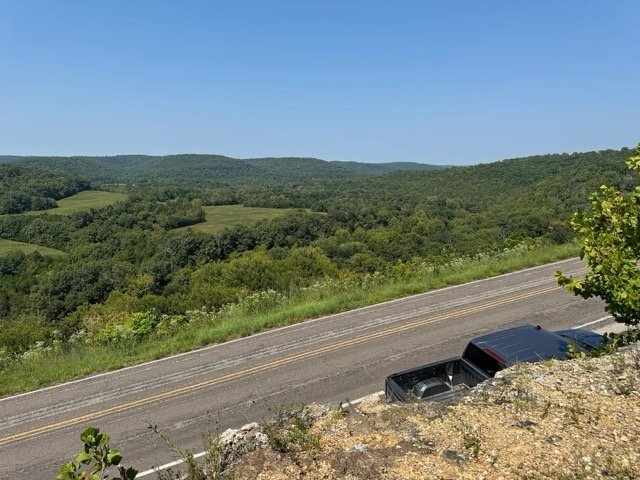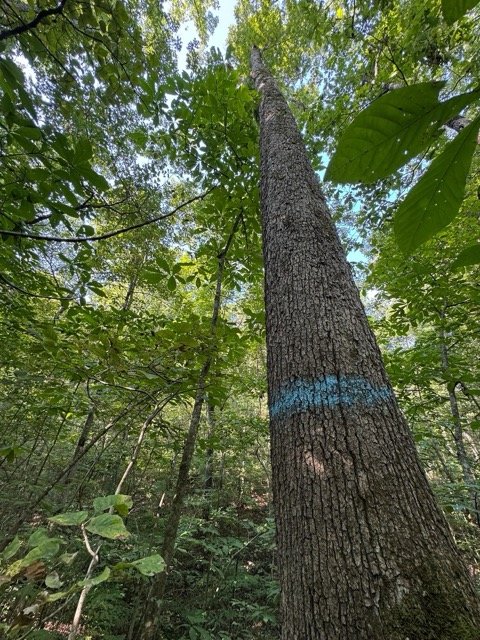Pioneer Forest
View near Akers Ferry, partially overlooking Pioneer Forest lands
In 1951, my grandfather, Leo A. Drey, began to purchase forestland in the Missouri Ozarks. No single motivation can be ascribed to this expansive work of his. In my two months on the forest this summer, though, I have been most interested in one of these: his intention to show single tree selection's economic and ecological potential for the Missouri Ozarks. The name he eventually chose for his forest then, Pioneer, seems more than appropriate. His own words though, taken from a self-recorded history, capture the name’s significance far more eloquently than I ever could:
“So that was my initial objective, to try to buy such an acreage and to see that it was managed along conservation lines, through individual tree selection as a demonstration project that I called Pioneer Forest, since what I was undertaking was a pioneering effort in many respects.”
When compared to clearcutting, single tree selection appears to be a laborious process. The reality of that fact was not entirely made clear to me until I experienced firsthand the process of marking trees. The seven foresters presently employed by Pioneer Forest engage in a careful balancing act, applying their knowledge to each ecological puzzle piece. Before my internship at Pioneer, I imagined a simple process (no more than putting paint on the trees of appropriate diameters). This misconception seems absurd in retrospect.
As I tromp through the forest alongside the forester whose timber sale I am visiting for the morning, I am astounded by his attention to detail. He points out a stand of trees to me. He draws my attention to their spacing; trees competing for sunlight can stunt each other's growth, slowing their development and stunting their growth. Then he begins to consider which tree to mark. He considers their diameters, balancing the desire to preserve “crop” trees for their ultimate potential with the need to only mark trees that the loggers will be able to sell. Certain trees threaten to damage or knock down others as they fall, an obstacle that can be remedied by avoiding them altogether or by marking the ones they will strike as they fall. Finally, after more consideration, he uses a paint gun to draw a line of blue paint across the tree he has decided to remove. When I inquire about his justifications for marking the tree he chose, he is typically able to explain his reasoning for minutes, but as he marks, each tree only takes a moment of instinctual consideration.
A white oak tree marked for cutting
When those skills are applied over the course of a career, a forester in the Ozarks is able to manage around 25,000 acres of land, a number that my grandfather determined would cover the costs associated with harvesting the timber. Thus we return to the economic viability of single tree selection. The process incurs certain costs that are not present in a clearcutting management strategy. Measured purely in board-footage, a clearcut acre is not comparable to a selectively cut acre. The logger and the owner of the land will make a much greater return, not to mention the cost of employing the forester necessary for single tree selection. That said, clearcutting incurs costs of its own, which are often apparent concretely in the land.
One afternoon after we had finished marking timber, one of the foresters drove me to see an adjacent property owner’s land. The contrast between it and Pioneer Forest is hard to put into words. Just recently, the owners had begun to “liquidate” all of the timber on the property to cope with recently slumping profits. Once clearcut, land in the Ozarks will not yield valuable lumber for another 80 years. While it is still a viable approach to forestry, the hope of Pioneer Forest is to show that it is not the only reasonable method of logging.
The clearcutting management strategy still being practiced by some of Pioneer’s neighbors is not unlike the one employed more than 70 years ago by National Distillers, from whom my grandfather purchased much of his land. It is an approach which seems to me as persistent as it is pervasive.
“Instead of cutting conservatively, the way [their foresters] wanted them to, [National Distillers was] liquidating all of the white oak on their property. National Distillers had bought the land during [WWII], not knowing whether they’d be able to find stave bolts to make whiskey barrels out of after the war, but evidently they found they were able to acquire what they needed, and decided to liquidate part of their investment by liquidating the white oak on their property.”
Above (left to right): Ed Woods, Leo Drey, and Charlie Kirk- L-A-D Foundation
I have been told by several foresters that I arrived at Pioneer during a difficult time. The complex puzzle pieces of tree selection have been jumbled by an unusual trend of red oak mortality. The mature red oaks across the forest were struck in rapid succession by a series of climate-related droughts, infestations by red oak borers (a kind of beetle), and armillaria root rot, a form of fungus that poses a much greater danger to already weakened trees. Several of the foresters have apologized that my internship coincided with such an unusual set of circumstances. On some level though, I instead feel gratitude. Watching the foresters contend with the natural obstacles of managing a forest has given me insights not only into the complex choices they make but also into the great admiration that my grandfather had for their profession.
There is a certain grit and adaptability that I have found so apparent in my time spent among them. Although Pioneer forest has faced similar die-off events before, these men truly earn its name. I no longer view the forest as my grandfather’s static legacy but as a dynamic organization, ever adapting to a changing world. My mother has often described to me the trust my grandfather placed in his employees, but only in this past month have I come to understand how much that means.



